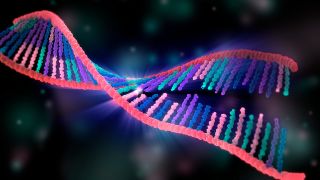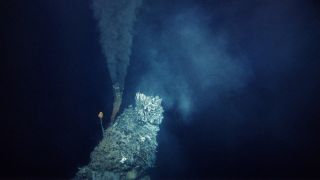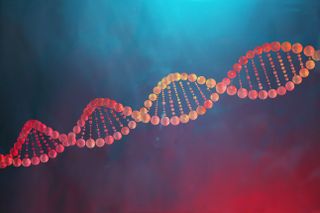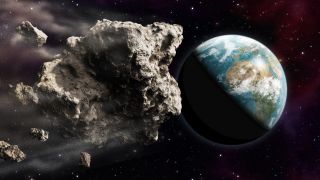7 theories on the origin of life
The answer to the origin of life remains unknown, but here are scientists best bets

The origin of life on Earth began more than 3 billion years ago, evolving from the most basic of microbes into a dazzling array of complexity over time. But how did the first organisms on the only known home to life in the universe develop from the primordial soup?
Science remains undecided and conflicted as to the exact origin of life, also known as abiogenesis. Even the very definition of life is contested and rewritten, with one study published in the Journal of Biomolecular Structure and Dynamics, suggesting uncovering 123 different published definitions.
Although science still seems unsure, here are some of the many different scientific theories on the origin of life on Earth.
It started with an electric spark

Lightning may have provided the spark needed for life to begin.Electric sparks can generate amino acids and sugars from an atmosphere loaded with water, methane, ammonia and hydrogen, as was shown in the famous Miller-Urey experiment in 1952, according to Scientific American. The experiment's findings suggested that lightning might have helped create the key building blocks of life on Earth in its early days. Over millions of years, larger and more complex molecules could form.
Although research since then has revealed the early atmosphere of Earth was actually hydrogen-poor, scientists have suggested that volcanic clouds in the early atmosphere might have held methane, ammonia and hydrogen and been filled with lightning as well, according to the University of California
Molecules of life met on clay
The first molecules of life might have met on clay, according to an idea elaborated by organic chemist Alexander Graham Cairns-Smith at the University of Glasgow in Scotland. Cairns-Smith proposed in his 1985 controversial book “Seven Clues to the Origin of Life'', that clay crystals preserve their structure as they grow and stick together to form areas exposed to different environments and trap other molecules along the way and organise them into patterns much like our genes do now.
The main role of DNA is to store information on how other molecules should be arranged. Genetic sequences in DNA are essentially instructions on how amino acids should be arranged in proteins. Cairns-Smith suggests that mineral crystals in clay could have arranged organic molecules into organized patterns. After a while, organic molecules took over this job and organized themselves.
Although Cairns-Smith's theory certainly gave scientists food for thought in the 1980s, it has still not been widely accepted by the scientific community.
Life began at deep-sea vents

The deep-sea vent theory suggests that life may have begun at submarine hydrothermal vents spewing elements key to life, such as carbon and hydrogen-, according to the journal Nature Reviews Microbiology.
Hydrothermal vents can be found in the darkest depths of the ocean floors, typically on diverging continental plates, according to the Natural History Museum. These vents erupt fluid which is superheated by the Earth’s core as it passes up through the crust, before being ejected at the vets. During its journey through the crust it collects dissolved gases and minerals, such as carbon and hydrogen.
Their rocky nooks could then have concentrated these molecules together and provided mineral catalysts for critical reactions. Even now, these vents, rich in chemical and thermal energy, sustain vibrant ecosystems.
Abiogenesis by way of hydrothermal vents continues to be investigated as a plausible cause of life on Earth. In 2019, scientists at University College London, successfully created protocells (non-living structures that help scientists understand the origins of life) under similar hot, alkaline environmental conditions to hydrothermal vents.
Life had a chilly start
Ice might have covered the oceans 3 billion years ago and facilitated the birth of life. "Key organic compounds thought to be important in the origin of life are more stable at lower temperatures,” Jeffrey Bada at the University of California, told New Scientist. At normal temperatures these compounds, such as simple sets of amino acids, are sparsely populated in water, but when frozen become concentrated and facilitate the emergence of life, according to Bada’s work published in the journal Icarus.
Ice also might have protected fragile organic compounds in the water below from ultraviolet light and destruction from cosmic impacts. The cold might have also helped these molecules to survive longer, enabling key reactions to happen.
The answer lies in understanding DNA formation

Nowadays DNA needs proteins in order to form, and proteins require DNA to form, so how could these have formed without each other? The answer may be RNA, which can store information like DNA, serve as an enzyme like proteins, and help create both DNA and proteins, according to the journal Molecular Biology of the Cell. Later DNA and proteins succeeded this "RNA world," because they are more efficient.
RNA still exists and performs several functions in organisms, including acting as an on-off switch for some genes. The question still remains how RNA got here in the first place. Some scientists think the molecule could have spontaneously arisen on Earth, while others say that was very unlikely to have happened.
Life had simple beginnings
Instead of developing from complex molecules such as RNA, life might have begun with smaller molecules interacting with each other in cycles of reactions. These might have been contained in simple capsules akin to cell membranes, and over time more complex molecules that performed these reactions better than the smaller ones could have evolved, scenarios dubbed "metabolism-first" models, as opposed to the "gene-first" model of the "RNA world" hypothesis.
Life was brought here from elsewhere in space

Perhaps life did not begin on Earth at all, but was brought here from elsewhere in space, a notion known as panspermia, according to NASA. For instance, rocks regularly get blasted off Mars by cosmic impacts, and a number of Martian meteorites have been found on Earth that some researchers have controversially suggested brought microbes over here, potentially making us all Martians originally. Other scientists have even suggested that life might have hitchhiked on comets from other star systems. However, even if this concept were true, the question of how life began on Earth would then only change to how life began elsewhere in space.
Additional resources
For more information into the theories of life’s origins check out “The Stairway To Life: An Origin-Of-Life Reality Check” by Change Laura Tan and “The Mystery of Life's Origin” by Charles B. Thaxton, et al.
Bibliography
Matthew Levy et al, “Prebiotic Synthesis of Adenine and Amino Acids Under Europa-like Conditions”, Icarus, Volume 145, June 2000, https://doi.org/10.1006/icar.2000.6365
William Martin, “Hydrothermal vents and the origin of life”, Nature Reviews Microbiology, Volume 6, September 2008, https://doi.org/10.1038/nrmicro1991
K. A. Dill and L. Agozzino, “Driving forces in the origins of life”, Open biology, Volume 11, February 2021, ttps://doi.org/10.1098/rsob.200324
Ben K. D. Pearce et al, “Origin of the RNA world: The fate of nucleobases in warm little ponds”, PNAS, Volume 114, October 2017, https://doi.org/10.1073/pnas.1710339114
Sign up for the Live Science daily newsletter now
Get the world’s most fascinating discoveries delivered straight to your inbox.
